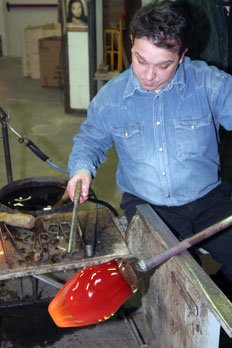
Luca Vidal was born in Venice on July 1, 1976. At the young age of 14 he started to work with glass studying under the Glass Maestro Imperio Rossi in Murano before becoming the youngest glass worker under the tutelage of the masters at Effetre Studio. Vidal has worked over the years with many of the most important Glass Maestros on Murano; men like Afro Celotto, Silvano Molin, Luciano Pavanello, Giancarlo Tagliapietra and Dino Vio.
Luca Vidal now expresses his own ideas and techniques in the one-of-a-kind sculptures he creates. It is in this period that his colleagues give him the nickname “Crema”, due to his natural ability to gracefully shape glass as a “cream”.
In 2000, while working at the Artistic Glass Factory Schiavon, Luca Vidal again had the opportunity to work with the great Maestro Afro Celotto, with whom he had also known at Effetre. One year later, after learning the techniques of filigrana, mosaics and tessere murrines, he decided to open a new studio with Afro Celotto and Carlo Tagliapietra. In 2009, when Afro Celotto left the studio, it gave Vidal the chance to express his own talents and energy.
Interesting (and random) Facts About Glassblowing on the Island of Murano
courtesy of Gianluca Vidal
“Knowledge is the key to understanding and appreciating the true value of fine art glass.”
Glass at one point in history was a very valuable commodity available only in small sizes and to the very wealthy. With the invention of glassblowing, glass became accessible to the general public.
Glass was first produced in the Middle East around 3000 BC.
Glassmaking existed in Venice from as early as the 8th century and has been operating continuously since that time.
Glass was one of the Renaissance world’s most coveted treasures.
In 1291, the government of Venice banned the furnaces from central Venice, moving them instead to the island of Murano. This was due to the fear of fire in the wooden structures of a crowded Venice and also to isolate the master glassblowers to prevent their sharing valuable glassmaking secrets. The glassblowers became virtual prisoners on Murano, where the penalties for divulging glassblowing secrets could include death.
Glassmakers were considered “royalty” and had many privileges. They could wear swords and enjoyed immunity from prosecution. The daughters of glassmakers were allowed to marry into Venice’s blue-blooded families.
Glass products were highly prized in the Middle Ages and were predominantly responsible for the power and wealth of the Venetian empire at that time.
In 1450 there was a technological revolution in Venetian glass that was so important that it marked the end of the Middle Ages and the beginning of the Renaissance. Angelo Barovier discovered how to remove the impurities from the soda ash that caused discoloration in glass. This invention of Cristallo allowed for the creation of clear crystal objects.
Secret glass making recipe books are passed down from fathers to sons in glassmaking families.
It is in the hot modeling of glass that Murano glassmakers excel.
The master glassmakers of Murano are able to blow very thin and airy forms that are delicately shaped, using only a few simple iron tools. These tools are virtually the same today as they were a thousand years ago.
For information on more available work from this artist, please contact us.